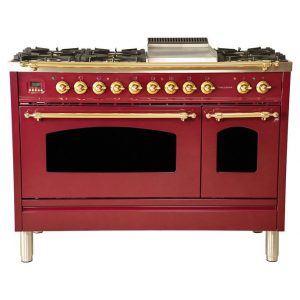What’s the best stove for your home? With so many options on the market these days it can be hard to pick. In addition to the old stand-bys, electric and gas, there are new-fangled ones like induction stoves and even something called “dual fuel.” But rest assured, there are clear pros and cons to each. To help you find the right type of stove for you, allow us to boil this complex topic down into delicious, bite-size nuggets.
Electric coil
These old school cooktops are great if you’re watching your finances … or if your idea of “cooking” is more Hamburger Helper than Martha Stewart.
Pros: This type of stove can set you back as little as $400, says Dan DiClerico, a home expert for HomeAdvisor. And it’s not costing you that much in performance. “The coils do a very good job of heating up at a range of temperature levels, especially the simmer setting, which can be a challenge for more powerful cooktops,” he notes.
Electric coil ovens tend to be roomy as well, since there’s no convection fan or pesky technology taking up space.
Cons: Basic construction = a pretty vanilla look, so “you’re not going to win any design awards with an electric coil cooktop in the kitchen,” DiClerico says.
One to consider: Consumer Reports gives high marks to the Kenmore 94142 range ($489.99).
Electric smoothtop
Have a bit more of a budget to work with and crave a fully modern-looking kitchen? These sleek electric models are a popular mid-market option, with most falling in the $1,000 to $1,500 range.
Pros: The biggest perk here is the smoothtop surface is a cinch to wipe down. You don’t have to worry about food falling under any electric coils or coming into contact with gas burners. Plus, “This type of cooktop delivers excellent heating,” DiClerico says. “Most models have expandable elements that make it easy to match the amount of heat to the size of your cooking vessel.”
Bonus: Electric smoothtops often have at least one high-powered element, which allows you to power-boil a pot of pasta.
Cons: Smoothtop surfaces aren’t indestructible. “You’ll need to care for it properly,” says DiClerico. That means not dragging heavy pots across the top and promptly cleaning spills. Certain foods, especially those high in sugar, will bond to this surface if you leave them too long.
Another potential downside, especially if you have small kids? “Electric smoothtops tend to stay hot for a while after being turned off,” DiClerico cautions.
One to consider: Ben Pugliares, manager of major appliances for Wayfair.com, says the GE 30″ Free-Standing Electric Range ($899) is a best-seller with high marks from customers.
Gas
Gas stoves remain the undisputed appliance choice for foodies, since you can control the temperature to a tee.
Pros: “The visual recognition of the live flame makes it easy to judge the level of heat and temperature,” DiClerico says. Gas burners also make it easy to quickly switch from a high temperature to a lower one—which is important when you’re trying to, say, sear a steak.
Cons: Gas stoves tend to be priced around $1,500 to $2,000. Looking at a pro-style range, with beefy controls and an industrial design? You may shell out around $5,000.
And be aware: All those crevices around the burners can be a pain to clean, not to mention that you might not love the oven as much as you love the cooktop. A common complaint from bakers is that gas-powered ovens don’t heat evenly.
One to consider: Joana Chatelain, senior buyer of large appliances for Overstock.com, recommends the Frigidaire FFHF3051T Free-Standing Natural Gas Range ($676). Have more wiggle room in your budget? Pugliares suggests the Thor Kitchen Professional 48” Free-Standing Gas Range ($4,600).
Induction
Welcome to the next big thing in cooking! Instead of using radiant heat of a flame or electricity, a quickly alternating electromagnetic current causes the metal in the bottom of your pot or pan to heat up—essentially turning the utensil into the cooking surface.
Pros: “Induction ranges are the fastest and most energy efficient way to cook. They also offer the most consistent temperatures,” says Pugliares.And because the induction cooktop surface itself doesn’t get hot—only the actual cooking vessel—this type of range is a safe choice if you have small children.
Cons: An induction cooktop only works with magnetic cookware, so if you typically use nonstick cookware, you’ll need to go pot and pan shopping.
One to consider: Frank Proto, a chef instructor at the Institute of Culinary Education, votes for the GE Monogram Induction Cooktop ($2,800).
Dual fuel
Think of this as the peanut butter cup of kitchen ranges: The burners run on gas, but the oven is electric. (A boon for bakers.)
Pros: You’re getting the best of both worlds—the power and quick response of a gas range, with the lower cost and efficiency of an electric oven, says Pugliares.
Cons: If you’re currently using a gas range, you’ll need to get set up for electric—or vice versa. Plus, double the power, double the potential problems.
“If one type breaks, you need to get a whole new stove or work with half,” says Proto.
One to consider: Pugliares commends the Hallman Industries Free-Standing Dual Fuel Range with Griddle ($7,999.99). Looking for something cheaper? Chatelain’s vote is for the Zline Gas Burner/Electric Oven($1,992).
Original Article